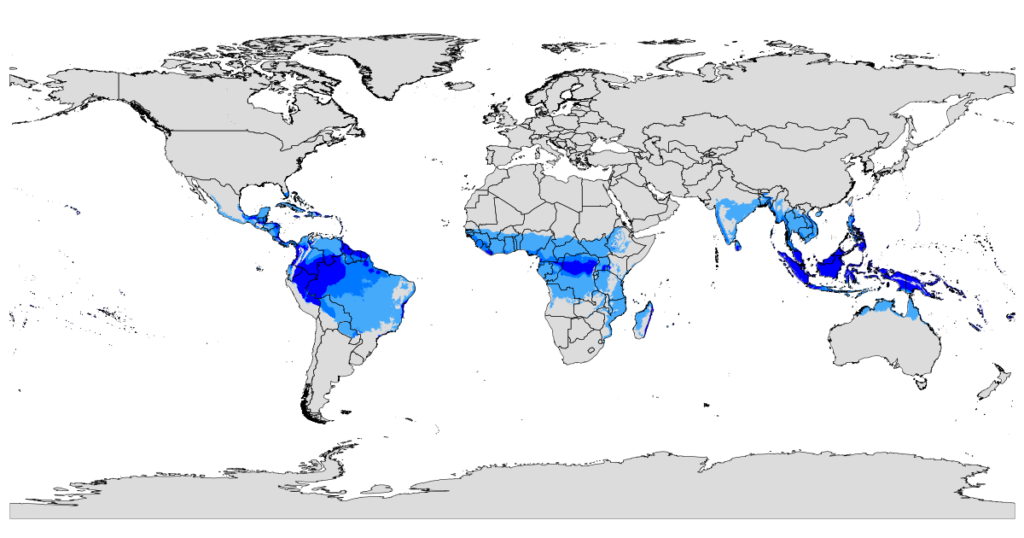Tropical Climate Characteristics refer to the features of a non-arid climate with a consistent temperature of over 18°C or 64°F throughout the year. Unlike other regions, tropical climates are characterized by two distinct seasons – wet and dry.
This means that in tropical regions, there is no significant temperature variation between the seasons, but there is a notable difference in rainfall patterns. In this type of climate, the ecosystem is adapted to a significant amount of rainfall followed by extended periods of dry weather, which affects everything from agriculture to flora and fauna. Understanding the unique features of tropical climates is essential for anyone living, working, or studying in such regions.

Tropical Climate Characteristics
It is a non-arid climate characterized by specific features. The term “tropical” is derived from the fact that these regions typically have average warm or hot temperatures. This climate pattern can have the wet season in either the high-sun half or the low-sun half of the year. The high-sun half spans from April to September in the northern hemisphere and from October to March in the southern hemisphere. Meanwhile, the low-sun half runs from October to March in the northern hemisphere and from April to September in the southern hemisphere.
One of the most notable features of tropical climates is that they are typically frost-free, and there is slight variation in the solar angle throughout the year. As a result, temperatures in these regions tend to remain relatively constant, with the sun’s warmth intense throughout the year. This creates a hot and humid environment that can be challenging for those who are not accustomed to it.

Despite the challenges posed by tropical climates, they are also home to some of the most diverse ecosystems on the planet, with lush rainforests, coral reefs, and other unique habitats teeming with life. Understanding the tropical climate characteristics is essential for those who live or work in these regions, as well as for scientists and policymakers who are studying climate change and its impact on these vital ecosystems.
Tropical Rainforest Climate
Tropical rainforest climates are found in regions close to the equator, approximately 10-15 degrees north and south latitude. These areas are dominated by the doldrums of the intertropical convergence zone, which creates calm winds, sinking air, and frequent rainfall. Heavy seasonal rainfalls, often exceeding 200 cm or 80 inches annually, are a defining characteristic of this climate. There is either no dry season or, at most, two dry months, ensuring that the average precipitation of at least 60 mm or 2.4 inches occurs throughout the year.
Several regions of the world have tropical rainforest climates, including the Amazon basin in South America, the Congo basin in equatorial Africa, and the oceanic margins of some parts of tropical West Africa. The largest area with this climate is found in Southeast Asia, encompassing insular and peninsular regions such as Malaysia, Thailand, New Guinea, the Philippines, and Indonesia.
In addition to these regions, small areas with tropical rainforest climates can be found in the Caribbean islands and Eastern Central America, Brazil’s Atlantic margins, eastern Madagascar Island, and southern Ceylon. These areas are home to some of the most diverse ecosystems on Earth, with an abundance of flora and fauna that are unique to this type of climate.
The importance of tropical rainforests to global ecosystems cannot be overstated. They regulate the Earth’s climate, absorb carbon dioxide, and produce oxygen. Unfortunately, deforestation, climate change, and other human activities threaten many of these regions. As such, it is essential to protect and conserve these valuable resources to ensure the continued survival of our planet.
Tropical Monsoon Climate
This particular climate pattern results from the monsoon winds, which shift direction in response to the changing seasons. This type of tropical climate features a brief and well-defined dry period.
During the high sun season, typically in the summer, this region falls under the influence of the intertropical convergence zone. Conversely, during the low sun season, generally in the winter, the climate is influenced by drier trade winds. These alternating weather patterns create a unique and dynamic climate that can impact many aspects of life in the region.
Overall, the monsoon winds play a crucial role in shaping this climate pattern, which features distinct wet and dry seasons. Understanding the influences of these winds and the resulting weather patterns can be essential for planning and adapting to life in this region.






